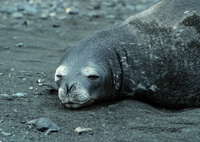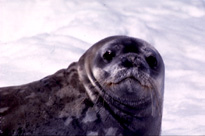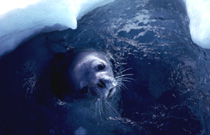Weddell Seal
(Leptonychotes weddellii)
IUCN STATUS (2010) - LEAST CONCERN
| Distribution and Numbers Usually found on near-shore fast ice, unlike the other Antarctic seal species which prefer the pack ice, there are estimated to be about 800,000 Weddell seals around the Antarctic continent. Small populations also breed on South Georgia, the South Sandwich Islands, the South Shetland Islands and the South Orkney Islands. The species is named after the sealer Captain James Weddell who wrote about his encounters with the seals in the 1820s. |
| Status Weddell seals have been protected in the past from commercial hunting by their inaccessibility, although many were killed to provide food for sled dogs, a practice no longer continued. All killing of seals in the Antarctic region is now regulated by the Convention for the Conservation of Antarctic Seals (CCAS) and the Antarctic Treaty. However a commercial hunt of 107 Weddell seals was carried out by the Soviet Union in 1986-1987. |
| A plan by Norwegian scientists to kill 20 Weddell seals, as well as 60 other seals, in the summer of 2000-2001 for research into environmental contaminants was cancelled after the Norwegian government rejected the plan. Several environmental organisations had vigorously opposed the plan, questioning its necessity and also its appropriateness given the option of alternative non-lethal sampling techniques. The proximity of Antarctic research bases to some Weddell seals has caused a measure of disturbance in the past. In January 1998 the Environmental Protection Protocol to the Antarctic Treaty was ratified, implementing environmental measures such as the banning of mining and oil drilling in Antarctica for at least 50 years, along with the banning of refuse disposal and the use of pesticides in the region. |
 Photo: Tom Arnbom, University of Stockholm |
| The importance of krill in the diets of the fish and squid on which Weddell seals feed, along with current pressures on krill stocks from the commercial fishery, could result in the species experiencing a diminished food supply. |
| In January 2000 it was reported that Chilean scientists had found Brucella antibodies in a Weddell seal sample and Antarctic fur seal samples obtained in the South Shetland Islands, the first discovery of antibodies to the serious reproductive disease Brucellosis in Antarctic seals. |
| Lifestyle More is known about the lifestyle of the Weddell seal than any of the other Antarctic species. Females haul out on the fast ice in pupping colonies in September (in the more northerly areas), October and November in order to give birth to their pup. The females in a colony are well spaced out and the location of these colonies is alongside annual tide cracks or broken ice. The pup is born with a soft grey, grey brown or golden coat which it moults completely after six weeks. The female nurses her pup for 5-6 weeks, the pup often starting to accompany its mother into the water after about two weeks. |
 Photo: Michael Bryden, University of Sydney |
Towards the end of the nursing period the female mates under the ice, the males having maintained underwater territories beneath cracks in the ice with access to several females. Weddell seals use their specially modified front teeth to maintain ice holes in the fast ice to breathe. Studies have shown that adult seals are usually faithful to the same pupping colonies each year, most of them staying within tens of kilometres of the same site all year round. Immature Weddell seals tend to inhabit the pack ice all year round rather than the fast ice region, only moving to the fast ice and selecting a colony when they reach maturity. By the time Weddell seals reach adulthood their coat is usually quite dark, mottled with large darker and lighter patches, more of the lighter patches on the front. Weddell seals moult from December to March. |
| Weddell seals are highly vocal and their underwater calls are normally quite audible to a listener on the surface of the ice. Being versatile feeders, the main food for the Weddell seal is fish, such as the Antarctic cod and Antarctic silverfish. They also eat some cephalopods and crustaceans. Young seals in the pack ice region are more dependent on pelagic prey. Recent research using video cameras attached to Weddell seals showed that the seals are stealth hunters, approaching within centimetres of cod without startling the fish, and that they do not appear to use sound to hunt, relying instead on their acute underwater vision and often using the under-ice surface for backlighting. The seals were observed flushing out smaller fish by blowing air into sub-ice crevices, and were able to return to a small air hole in the ice after travelling almost 3km away. Weddell seals are excellent divers and feeding dives to depths of 200-400m for periods of up to 15 minutes are common. Adult seals suffer little from predation due to their inaccessible location in fast ice and heavy pack ice regions. However some Weddell seals, especially younger seals, are preyed upon by killer whales and to a lesser extent by leopard seals, particularly in the spring and summer when the ice breaks up. |
| Statistics Adult males can measure up to 2.5-2.9m in length, adult females slightly longer at up to 3.3m. Weddell seals can weigh up to 400-600kg. Pups are born measuring about 1.2-1.5m in length and weighing 22-30kg. The juvenile mortality rate for Weddell seals is less than that of the other Antarctic species because of the lesser threat of predation. Individuals have been known to dive up to 600m in depth and a 73 minute dive was once recorded. Females become sexually mature at about 3-6 years, males at 7-8 years. Weddell seals can live up to 22 years of age. |
 Photo: Michael Bryden, University of Sydney |
